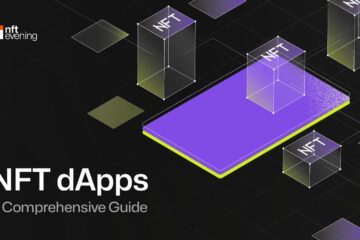DeFi (Decentralized Finance) changed the way people think about money, giving anyone with a wallet the chance to lend, borrow, or earn yield without needing a bank. NFTs (Non-Fungible Tokens), on the other hand, started out as digital art and collectibles. But the line between these two is blurring fast.
A new wave of hybrid financial products is emerging, pulling together the utility of DeFi with the uniqueness of NFTs. These on-chain assets are no longer just speculative toys or collectibles. They’re becoming tools for building entirely new types of value.
So, why is this happening now, and what does it mean for users, investors, and the wider financial system?
DeFi’s Foundation: Programmable Finance
DeFi is about automating financial functions using smart contracts. Lending, borrowing, trading, and earning interest can all be done on-chain, without the need for a middleman.
Users can:
- Provide liquidity – Deposit tokens into pools and earn rewards or fees
- Borrow funds – Use crypto as collateral to access instant loans
- Stake tokens – Lock in assets for yield or governance rights
- Trade seamlessly – Swap assets with minimal slippage and full transparency
The transparency and composability of these services make DeFi extremely flexible. But up until now, most of it has been centered around fungible tokens, currencies that are identical and interchangeable.
That’s where NFTs shake things up.
NFTs: Not Just About Art Anymore
NFTs introduced scarcity and uniqueness to blockchain assets. Each token can carry its own identity, metadata, and utility. In gaming, this meant items and skins. In art, it meant ownership and royalties. But financial applications? That’s newer territory.
NFTs are being used to:
- Represent ownership of yield-bearing positions
- Act as collateral for loans
- Track the performance history of user accounts
- Unlock access to tiered DeFi services
By wrapping DeFi positions inside NFTs, developers are turning financial contracts into tradable, portable assets. Imagine your loan position, staking history, or liquidity share represented as a unique digital object you can sell, trade, or transfer. That’s where the real innovation is starting.
New Asset Class: The Financial NFT
The term “Financial NFT” is being used more often to describe these new types of on-chain instruments. They bundle traditional DeFi mechanics with the flexibility and uniqueness of NFTs.
Let’s break down a few real-world examples:
| Type | Use Case |
| NFT Collateral | Borrowing crypto against NFTs without needing to sell them |
| Yield-Bearing NFTs | Liquidity pool positions wrapped as NFTs, earning fees or rewards |
| Tokenized Loan Agreements | Loans issued as NFTs that can be traded or transferred mid-term |
| Credit History NFTs | Track borrowing behavior, improve future loan terms |
| Access Pass NFTs | Gateways to exclusive protocols, governance, or high-yield strategies |
These models are already live across various DeFi protocols, and more are emerging.
Why This Hybrid Model Matters
Bringing together DeFi and NFTs is not just a novelty. It’s solving real-world frictions that exist in traditional finance, as well as in earlier versions of decentralized systems.
1. Liquidity of Positions
In traditional finance, selling a bond or loan contract might involve paperwork and counterparty risks. In DeFi, when these are wrapped as NFTs, you can instantly sell them on-chain with full transparency.
2. Personalization of Finance
NFTs let users hold unique financial assets tailored to their needs. This personalization isn’t possible with standard fungible tokens.
3. Enhanced User Experience
Financial NFTs offer cleaner interfaces. Instead of managing multiple positions across different platforms, everything can be wrapped and managed as a single, portable NFT.
4. Interoperability
These hybrid assets are composable. A single NFT might interact with several protocols, earning yield in one while acting as collateral in another.
This shift has also opened new paths for traders and everyday users. For example, those already active on a cryptocurrency trading platform can now explore alternative asset classes with real financial utility. It’s expanding the very idea of what “trading” means in a decentralized world.
Real-World Potential: Beyond Speculation
The current trend of wrapping DeFi functionality into NFT form isn’t just about experimenting with the tech. It’s about building financial products that behave in more flexible, modular ways.
This opens up a range of new uses:
- Fractionalized Ownership – Split a high-value NFT into shares for group investment
- On-Chain Credit Scoring – Use past performance to unlock better lending terms
- Subscription Models – NFTs granting limited-time access to strategies or pools
- Tradable Insurance – Risk coverage tokenized as NFTs that can be sold if no longer needed
There’s a logic behind it. Financial products need to be adaptable. Traditional markets move slow, rely on outdated infrastructure, and are often closed systems. DeFi and NFTs break that model apart.
And that’s attractive to more than just crypto users. Developers are creating financial instruments that can adapt on the fly, integrate with other services, and evolve as market conditions change.
Why It’s Gaining Momentum Now
This hybridization didn’t happen overnight. A few key shifts helped push it forward:
- Maturation of NFT tech – Standards like ERC-721 and ERC-1155 have matured, making it easier to build them
- DeFi stability – After the chaos of early experimentation, many DeFi protocols are now more secure and better understood
- User demand – There’s growing interest in owning financial assets that are both functional and tradable
- Cross-platform integration – NFTs can now be used across multiple apps, wallets, and marketplaces
Add to this the rising awareness of digital identity, privacy, and composability, and it’s clear this space is just getting started.
Where Utility Meets Creativity
NFTs aren’t just collectibles, and DeFi isn’t just for coders. When they merge, the result is a smarter, more dynamic form of finance.
As the tools become more polished and the risks better understood, we’re likely to see these hybrid assets integrated into everything from trading platforms to everyday payment systems.
Keep an eye on this space. It’s a signal that on-chain finance is evolving into something far more useful, flexible, and user-driven than anything we’ve seen before.
FAQ
Are NFTs in DeFi riskier than standard tokens?
They carry different risks. While smart contract bugs are always a concern in DeFi, NFTs can also be more illiquid depending on how niche the asset is. However, wrapping positions as NFTs doesn’t inherently make them more dangerous. It depends on how they’re implemented.
Can I use NFTs to improve my yield strategy?
Yes. Some platforms now allow yield positions to be minted as NFTs, giving you the option to trade or stake them elsewhere. This increases flexibility and may lead to higher returns if managed wisely.
Do I need to understand both DeFi and NFTs to benefit?
It helps. But many platforms are simplifying the process. As the space matures, expect better user experiences where the underlying technology is invisible to the user.
Is this only relevant to crypto-native users?
Not anymore. These hybrid models are drawing interest from more traditional traders and investors who are used to having a CFD trading account and want exposure to digital asset innovation without losing the structure they’re used to.
 Bitcoin
Bitcoin  Ethereum
Ethereum  Tether
Tether  XRP
XRP  USDC
USDC  TRON
TRON  Lido Staked Ether
Lido Staked Ether  Dogecoin
Dogecoin  Figure Heloc
Figure Heloc  Cardano
Cardano  WhiteBIT Coin
WhiteBIT Coin  Bitcoin Cash
Bitcoin Cash  Wrapped stETH
Wrapped stETH  Wrapped Bitcoin
Wrapped Bitcoin  USDS
USDS  Wrapped eETH
Wrapped eETH  Binance Bridged USDT (BNB Smart Chain)
Binance Bridged USDT (BNB Smart Chain)  Chainlink
Chainlink  Monero
Monero  LEO Token
LEO Token  WETH
WETH  Zcash
Zcash  Stellar
Stellar  Hyperliquid
Hyperliquid  Coinbase Wrapped BTC
Coinbase Wrapped BTC  Ethena USDe
Ethena USDe  Litecoin
Litecoin  Sui
Sui  Avalanche
Avalanche  Hedera
Hedera  sUSDS
sUSDS  Shiba Inu
Shiba Inu  USDT0
USDT0  Dai
Dai  Canton
Canton  Uniswap
Uniswap  PayPal USD
PayPal USD  Mantle
Mantle  Cronos
Cronos  Toncoin
Toncoin  World Liberty Financial
World Liberty Financial  Ethena Staked USDe
Ethena Staked USDe  Polkadot
Polkadot  USD1
USD1  Aave
Aave  Rain
Rain  Bitget Token
Bitget Token  MemeCore
MemeCore 


